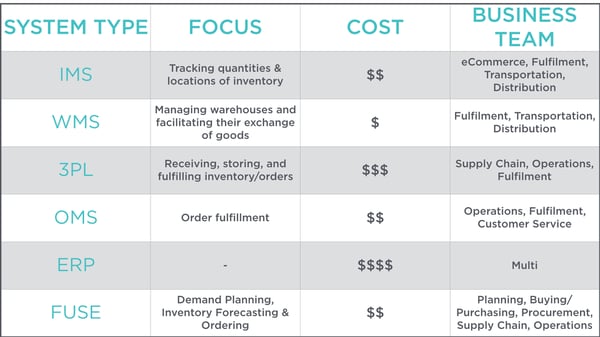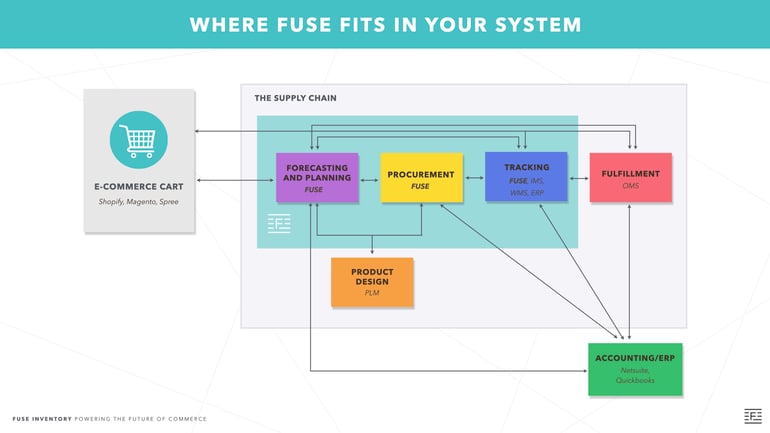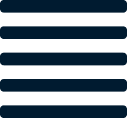As straightforward as inventory seems, the ways of managing, tracking, planning, and ordering it can differ. Many retailers use a combination of spreadsheets and softwares to keep track of this behemoth. But which systems do you actually need? The answer of course depends on what it is you’re trying to do. In this post we’ll cover what the different systems do to help you figure out which one you need.
IMS (Inventory Management System)
The role of an IMS is quite simple - track the quantities and locations of inventory. This can entail inventory that is on order or that which is being fulfilled or returned to and from the customer. Inventory management systems can also be used interchangeably with stock management or warehouse management systems, though there is a key difference in the latter.
A WMS oversees multiple warehouses and therefore, their details on inventory. A warehouse management system centralizes your warehouses in order to facilitate the distribution of goods.
A WMS is needed when you want to automate the receiving and sending of goods. Though these days, some inventory management systems also offer this functionality along with a host of other features such as order management, stock visibility, and PO generation.
3PL (Third-Party Logistics)
Similar to the overlap mentioned above between IMS and WMS, there is also some redundancy in what is offered by a 3PL. In short, a 3PL combines the logistics processes tied to inventory including: management, warehousing, and fulfilment.
Inventory is usually sent to a 3PL which will then go through a receiving process that documents what goods actually came in. Inventory is then stored until it is time for it to go out to the customer. A 3PL is responsible for packaging the finished goods before they get shipped out. So if the unboxing experience of your products is important to you, it’s important to find a 3PL with good reviews. You’ll want to look for a provider with brands in the same or similar industry as you, this way they are familiar with certain practices specific to your type of goods.
OMS (Order Management System)
Order management systems are known to manage all of the processes tied to orders and their fulfilment. This includes: allocating orders to the appropriate warehouse for shipping, processing the orders, and providing a record of data on the status of orders and the inventory they contain. So what’s the difference to the systems we’ve already mentioned? One word - focus.
OMS are most optimized for managing, you guessed it, orders. The same holds true for the relationship between IMS and inventory, WMS and warehouses, and 3PL and logistics. Each system, while offering an array of options, is best suited for its namesake operation. That brings us to our next contender - ERP.

ERP (Enterprise Resource Planning)
ERP systems encompass many of the functionalities mentioned in the systems above, and then some. These systems are a wide net solution, offering a little bit of everything and therefore a minimal focus on anything. Such systems are typically adopted by large companies due to their scope of capabilities and centralization. One of the benefits of such a platform is that there are minimal additional integrations needed, and so in terms of data, what the ERP says...goes.
Besides the lack of focus and attention, a downside for SMBs looking for a single solution is that ERP systems typically come at a high cost. And because their tools are adopted by a wide variety of clients and industries, customization to your needs is unlikely. So if the functionalities don’t suit your needs, it’s not quite worth the investment. Oftentimes large companies will end up adding other systems and tools down the line that come at a lower cost than paying for the customization of an ERP.

Fuse
What about Fuse? Where do we fit in all of this? Fuse Inventory is a true inventory planning and procurement tool. Fuse centralizes inventory, sales, and procurement data to generate a predictive forecast and inventory replenishment plan. For this reason, Fuse is adopted by those responsible for accurately ordering inventory, typically planners and buyers.
Planning is the practice of optimizing the ROI of buying and selling products to meet market demand at any given time and place. In other words, it ensures demand is met and there is limited excess inventory.
Can’t this all be done in excel? To some degree, all of the functions we mentioned in this post can be, but not well. In any role, there are anomalies and tedious processes that don’t scale well for growth. In inventory planning for example, brands are challenged by accurately predicting demand, adjusting for stockout periods, ordering components of finished goods with variable lead times, and accurately reflecting sales and inventory receipts. This is further burdened by the constraint of time, human errors, as well as your team and excel’s bandwidth. Further challenges emerge as businesses grow into a multi-channel presence.
Fuse uses predictive analytics and a machine learning algorithm to reflect trends in real time. No stagnant re-order points here. We look ahead to your demand, lead time, WOS target, incoming POs, and on hand inventory to tell you when and how much inventor to order. We even let you order it directly in Fuse. There are no limitations on SKUs, order volume, or number of users. We grow as you grow.
Some systems offer replenishment tools that are simplistic in nature. Put simply, the difference to Fuse is the equivalent of noting a shelf looks halfway empty vs quantifying the exact quantity and date to place an order based on your transit time, how much you want to hold on to, and what you’re going to consume.
Wondering if Fuse is right for you?
The world of SaaS solutions is overwhelming. We’d be happy to help you figure it out. Contact us through the link below to have someone on our team reach out to you.
.png)

.png)









.png)



%20hover.png)
.png)
hover.png)








Let us know what you think about this post
Put your comment below.